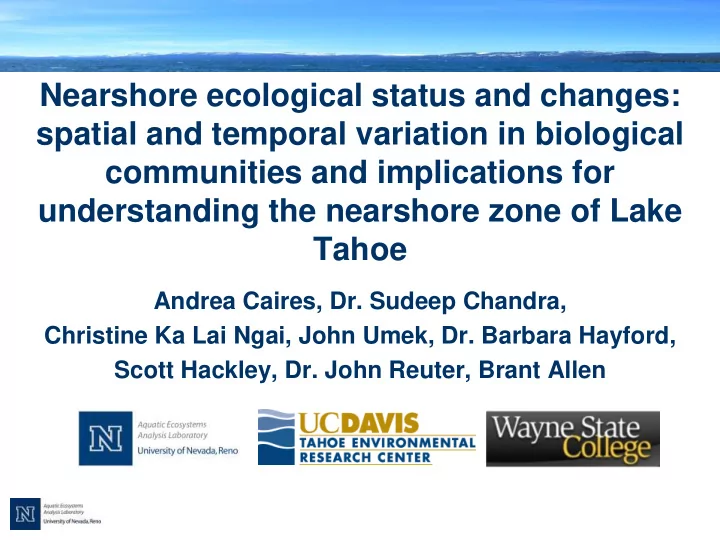

Nearshore ecological status and changes: spatial and temporal variation in biological communities and implications for understanding the nearshore zone of Lake Tahoe Andrea Caires, Dr. Sudeep Chandra, Christine Ka Lai Ngai, John Umek, Dr. Barbara Hayford, Scott Hackley, Dr. John Reuter, Brant Allen
Nearshore Lake Tahoe Photo by J. Umek Photo by C. Ngai Photo by C. Ngai
Nearshore Communities in Lake Tahoe Photo by M. Wittmann Photo by S. Hackley Illustrated by S. Adler and L. Hennessy, funded by UC Davis TERC
Importance of Nearshore Communities • Ecosystem function – Sediment mixing, organic matter breakdown, nutrient processing, food web interactions • Interface between terrestrial and aquatic environments – Nutrient exchange, food web interactions • Anthropogenic values – Recreation, aesthetic value
Monitoring Efforts in Nearshore Lake Tahoe • Invertebrate Surveys – “Hard substrate” collections: lake vacuum (2009) – “Soft substrate” collections: benthic dredge (2008-09) – Crayfish collections: minnow trapping (2009) Photo by J. Umek
Monitoring Efforts in Nearshore Lake Tahoe • Fish Surveys – Nearshore minnow trapping and snorkel surveys – Marina electrofishing collections Photo by J. Umek Photos by C. Ngai
Monitoring Efforts in Nearshore Lake Tahoe • Algal Surveys – Annual monitoring by TERC, UC Davis Photo by S. Hackley
Nearshore Community Spatial Patterns * * * * * * * *
Invertebrates Densities Driven by Periphyton?
Total Invertebrate Density vs. Chl a *Relationship driven by: -Chironomidae (midges) -Ephemeroptera (mayflies) -Utacapnia tahoensis (endemic stonefly) -Gastropoda (snails)
Total Invertebrate Richness vs. Chl a
Crayfish CPUE vs. Chl a
Minnow (Redside Shiner and Speckled Dace) CPUE vs. Chl a
Native Minnow Distribution 2009 June Tui chub 20 Tahoe Sucker CPUE (total catch/12h) Speckeled dace Redside 10 0
Fish Composition in Tahoe Keys 400 80 Native 350 70 No. fish captured WW Non Native 300 60 Shock Time (min) Time (min) 250 50 200 40 150 30 100 20 50 10 0 0 Jul-99 Aug-03 Aug-06 Aug-07 Jul-08 Jul-09
Marina vs. Non-marina Invertebrate Communities
Historical vs. Contemporary Nearshore Communities TERC State of the Lake 2010
Historical vs. Contemporary Periphyton Communities • Elevated periphyton communities in Tahoe City area since at least the 1960s – Abrahamsson 1970 – California-Nevada-Federal Joint Water Quality Investigation of Lake Tahoe, July 1969 – June 1970 – Goldman 1970
Historical vs. Contemporary Invertebrate Densities
Historical vs. Contemporary Invertebrate Community Structure Shifts
Historical vs. Contemporary Invertebrate Community Structure Shifts
Historical vs. Contemporary Native Minnow Communities
Summary • Hotspots of invertebrate and periphyton assemblages – Hard Substrate: northwestern corner of the lake • Spring periphyton growth appears to have a positive influence on invertebrate communities later in the season • Native minnow communities show a spatial pattern that differs from periphyton and invertebrate patterns • Marinas support a higher abundance of invertebrates and higher numbers of non-native fish species • Historical vs. contemporary community patterns – Periphyton and invertebrates appear to show similar spatial patterns in contemporary and historical abundance – Shift in nearshore invertebrate community structure – Native fish declines
Recommendations • Concurrent studies of nearshore communities in order to better understand interactions between taxa • Studies of community composition change over time (emphasis on change in taxonomic composition and associated implications)
Acknowledgements Funding: Jason Barnes California Tahoe Conservancy Robert Barnes Raph Townsend Marianne Denton Joe Sullivan Yasuko Nakano Jun Takai John Stefka Justin Tiano Cody Deane Sam Buffa
Recommend
More recommend